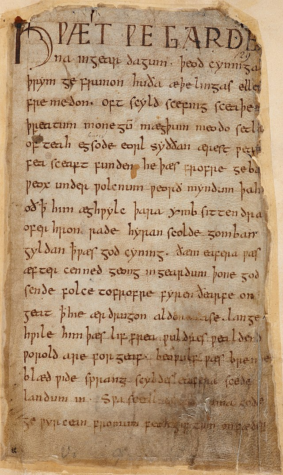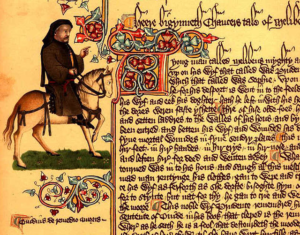The Evolution of Language Across Centuries
Our language continues to change and merge as cultures blend throughout history.
The expansion of a language’s vocabulary is endless, just as is its decline, as well,” said Jessica Chen’ 24. (Photo Credit: Joshua Hoehne / Unsplash)
What exactly is “Middle English”? I ask myself this as I wonder why The Canterbury Tales, written by Geoffrey Chaucer, is included in the Bronx Science English Department curriculum. I question whether it is necessary to read, as the book is written in an older style of English with the same themes of many other more modern books. So why is it relevant in today’s world?
Books like The Canterbury Tales hold many fundamental themes of everyday life for centuries. Certain problems and themes are recurring, which is shown through a literary piece written centuries ago.
Many students find the book a little difficult to read in its original Middle English. The main reason for this much confusion is the time period in which it was originally written. The modern English version of The Canterbury Tales that we read in my English class is not the original version written in Middle English, published in 1392.
Does this difference really matter? Is there a big difference between the different versions? What makes them really different? These questions linger in the back of our minds as we choose to read older texts.
In my English class, we read a Modern English translation of the Middle English original version of The Canterbury Tales, only to learn that the original version is completely different. The writing, pronunciation, and nearly every aspect of Middle English differs from the English we use today.
What changes a language over time?
Language can change quickly over a short period of time that we might not even notice how quickly the language is continuously developing. “I believe that there is a link between a language and its culture. A language is able to spread and develop a culture, whereas culture can also influence the development of the language itself.” said Jessica Chen ’24.
“I have always enjoyed learning languages, and I feel like there is significance in finding out the development of them as well,” Chen added.
During the 20th century, mass media caused a large increase in the English language vocabulary. New words such as ‘internet,’ ‘e-mail,’ and ‘download’ have never existed prior to the modern age. Every year, new words are added to every language.
Lexicographers specifically choose new words that they believe will stick and be around for at least a few decades. They add words based on whether they are used amongst a large population in the same definition, if it will last for a long time, and whether it is appealing to a general audience. This criteria also applies to inventing new words as well. Thus, many modern day words in multiple languages have derived from the name of the discovery itself.
For example, the word “internet” was first introduced to the public in the United States. Other countries’ translations for the internet are words similar to it. In French it is ‘l’Internet,’ and in Gaelic it is ‘Idirlíon.’ These words are similar to the original word “internet” but unique to their own culture and language.
As the dictionary expands with hundreds of entries of new popular words, many will also start to slip off the pages over time.
Even grammar changes over time. A certain type of grammar structure is usually adapted over a multitude of generations. Speakers tend to simplify and make certain words, phrases, or grammar rules more effective and easy to use when speaking.
As these trends continue to be used within one generation, these changes are shared by the next, and the cycle repeats. Generation changes are a big factor in language evolution, as each generation speaks differently to accommodate growing changes as the years continue. Generations establish different vocabulary, slang, and pronunciation. The upcoming generations are then influenced by the languages of the past generations.
The main aspect that can drastically develop a language over an extremely short period of time is the blending with other cultures and subsequently other languages. Through trade, colonization, or conquest, ideas and cultures are spread from one nation to another, each with its own language.
“As the Native American or Indigenous peoples of the Americas became colonized and controlled by Europe, they began to lose their culture and identity. Europe established methods to ‘recivilize’ those that were not, which led to the oppression of the Indigenous tribes in the New World. Now, Indigenous culture and language have been lost because of the suppression they have faced by colonization,” said Chen.
An increase in diversity within countries leads to the expansion of cultures and their languages. People of different cultures end up adopting other aspects of the languages around them. This results in the borrowing of phrases, words, or grammatical structures. This is known as linguistic borrowing, which encourages changes in the language and an expansion of its vocabulary.
At the reign of Alexander the Great, he had conquered a large land mass of Europe. He had spread Greek culture to all parts of his conquered territories, which initiated the Hellenistic Period. The spread of Greek culture, language, and traditions spread all throughout Europe. It was widely acknowledged to be the main language spoken as well. As everyone under Alexander the Great spoke Greek and schools taught children in Greek, the Greek language influenced the native languages prior. Today, we can find traces of Greek in the romance languages and in English as well.
“I would also say ‘independence’ of a country can take a toll on its dominant language as well. A country’s independence allowed for the development of its own language and writing systems,” said Chen.
The Development of the English Language
We can categorize the English language to have gone through three separate stages within its language development: Old English, Middle English, and Modern English.

One example of a work of literature written in Old English is Beowulf, which is also taught at Bronx Science as part of the English Department curriculum (it is also taught in a Modern English translation). The original author is unknown, but the piece is one of the most popular English epics (extremely long poems), especially because of how long ago it was written. Beowulf is a long epic poem that follows a heroic protagonist against many quests against evils, specifically against a monster named Grendel.
Then in 1066 A.D., William the Conqueror (the Duke of Normandy) conquered England and took the throne. Under his reign, there was increased exposure and influences of French culture and language. French was the dominant language amongst the ruling class. Old French was used for the majority of the court and administration texts. As for a written language, Latin was mostly used, especially when it came to literature from the Catholic Church.
French exposure to Old English contributed to the development of Middle English. There were many changes in grammar, as some words were more commonly used than others, and also word order. French had completely influenced Old English in order to develop into something a little more linguistically similar.
The most famous work written in Middle English was the Canterbury Tales written by Geoffrey Chaucer.

The Canterbury Tales shares the journey of a group of pilgrims that journey to a shrine. They end up participating in a competition to find out which pilgrim tells the best tale. Each character is of a different occupation, background, and lifestyle. They each tell tales relating to their own lives and bring themes into each of their tales.
You may expect to be familiar with Middle English, but that is not the case. Middle English is somewhat different from the English that we use today. So how did English become so different in such a short timespan?
The vernacular language, or the language spoken by ordinary people, changes depending on which words or phrases are used more frequently. If a new definition is created and more frequently used than the original meaning, then that new definition begins to solidify its role in the dictionary. If speakers begin to change their way of speaking or the grammar of the language, then a new grammatical structure will develop to suit the evolving speakers. A language and its evolution completely depend on the speakers of a language and how they use it.
The differences between Modern and Middle English are prominent. English today is attributed to the slight changes and trends in the language in the last century. There is quite a major shift in the English language every century.
Looking back at Shakespeare’s writing from a little over 400 years ago, it is much more difficult to read for high school students than contemporary prose or poetry. Postmodern literature (literature after World War II) focuses on more different themes than prior written pieces. Some popular current-day themes are regarding identity, growing up, and mental health, while past recurring themes are of love, loss, and friendship.
What is considered a dead language?
A ‘dead’ language is defined as a language that no longer has native speakers.
Latin, for instance, is often referred to as a ‘dead language.’ This is because the language was the most spoken in Europe as the Roman Empire dominated, until the empire’s collapse after the capture of Constantinople. Ottoman culture would slowly integrate throughout the prior-Roman territories. In addition, Latin became a language for the upper classes and nobility. It was taught in schools, and the only ones who could afford an education at the time were the nobility. Latin maintained its relevance through the upper classes.
In 1517, Martin Luther changed all of this. He brought new beliefs to the table, including how The Bible should be accessible to all. The only way to establish this would be to translate The Bible into the vernacular, or the common language of the ordinary people. Luther officially published the German translation of the Latin Bible in 1534, allowing the average German person to interpret the scripture on their own.
Gradually, Latin became used less frequently. Even though Latin has no remaining native speakers, it doesn’t necessarily mean that it is a dead language. Latin has contributed to many of the most widely spoken languages across the world, such as English, Spanish, and French. When comparing these languages with Latin, the similarities are very evident. Latin continues to be taught in classrooms to this day and actually provides the fundamentals to learn other Romance languages. It’s quite a benefit knowing a bit of Latin when it can really help you out in the long run.
Timeline

Languages emerge, thrive, build cultures, and then reach their demise. It is an inevitable cycle that has occurred for hundreds of languages over the course of millions of years. Today, we can only see how different our languages have become compared to the past and build upon them. Who knows what our future can hold? There are possibilities that English will contain completely different slang in the years to come. We can only wait to see how our language develops.
Languages emerge, thrive, build cultures, and then reach their demise. It is an inevitable cycle that has occurred for hundreds of languages over the course of millions of years.
Shawna Khuu is a Staff Reporter for the ‘The Science Survey.' She enjoys listening to music in her spare time and finding new spots at which to volunteer....











